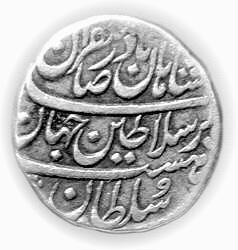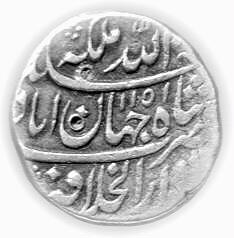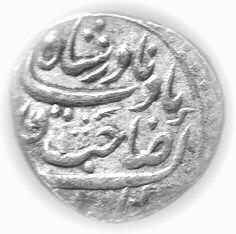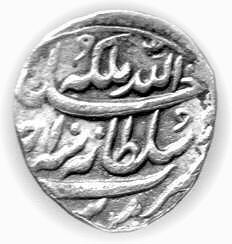
|
Events
News
Members
articles
Publications Book reviews Site search Internet Membership About ONS |

|
|
Jan Lingen Supplement to ONS Newsletters 161 For historical research one often has to convert the Hegira date to an AD date or the other way around. When doing this, one is often confronted with differences. When the difference in date appears to be approximately 11 days, it is clear that this is due to mixing up the Gregorian calendar with the Julian calendar. In the same article, dates can be found either according to the Julian calendar or the Gregorian calendar. When other people refer to these articles, the same mistake is usually copied. It is very important when using original sources (which is always preferred) to realise which era the AD date should be converted to. Introduction of the Gregorian calendar In 1582, Pope Gregory XIII introduced a new calendar to replace the Julian calendar in which the year was slightly longer. Most Roman-Catholic countries in Europe then adopted the new calendar, but the Protestant as well as the Greek-Orthodox countries changed to it much later1. England adopted the new calendar in 1752. In that year, the old Julian calendar changed to the new Gregorian calendar, when 3 September 1752 became 14 September 1752. This corresponds to the Hegira month of Dhu’l-Qa‘da, AH 1165. This was a 30-day month and the calculation is as follows:
Therefore, dates in original British documents, like those of the British East India Company, before the 3rd September 1752 should be calculated according to the Julian calendar. All dates mentioned thereafter correspond to the Julian calendar. Muhammad Shah’s regnal years Another mistake sometimes made, is the date from which the regnal years commenced. A notable example is the reign of Muhammad Shah and the dating of Nadir Shah’s invasion of India, which took place during his reign. Pridmore2 provides fine tables from all the Mughal emperors from Aurangzeb ‘Alamgir to Shah ‘Alam II and gives the date when the Hegira year commenced as well as the julus or regnal year. However, he made a mistake in respect of the date when the regnal years of Muhammad Shah commenced. The date of accession of Muhammad Shah is 15 Dhu’l-Qa‘da 1131 AH (19-09-1719) and Pridmore calculated the commencement of the julus or regnal years according to this date. According to Khafi Khan3, however, it was settled that the beginning of his reign should date from the deposition of Farrukhsiyar and should be so entered in the Government records. Accordingly, the regnal year of Muhammad Shah commenced from 9th Rab‘i II 1131 = 18 February 1719. This differs 7 months from his actual accession and leads inevitably to misinterpretations of the regnal years and the AH. date shown on his coins. Muhammad Shah ruled for less then 30 lunar years and Pridmore therefore had no explanation for coins with the regnal year 31; but if counted from his adopted accession date from the deposition of Farrukhsiyar, his reign lasted 30 lunar years and 18 days. The coins with regnal year 31 were struck during the period of these 18 days. During Muhammad Shah’s reign the devastating invasion of Nadir Shah took place. Nadir Shah’s stay in India lasted for only two months, and with such a discrepancy in regnal years, this soon leads to wrong conclusions. Table with the commencement of the AH dates and regnal years of Muhammad Shah in accordance with the Julian calendar Accession date: 15 Dhu’l-Qa‘da 1131 AH = 19-09-1719AD. Official date of accession is the date of the deposition of Farrukhsiyar: 9 Rab‘i II 1131AH = 18-02-1719 AD. AH date Commenced AD Ry. Date Ry. Commenced. 1131 13-11-1718 1 18-02-1719 1132 03-11-1719 2 08-02-1720 1133 22-10-1720 3 27-01-1721 1134 11-10-1721 4 16-01-1722 1135 01-10-1722 5 06-01-1723 1136 20-09-1723 6 26-12-1723 1137 09-09-1724 7 15-12-1724 1138 28-08-1725 8 04-12-1725 1139 18-08-1726 9 23-11-1726 1140 08-08-1727 10 13-11-1727 1141 27-07-1728 11 01-11-1728 1142 16-07-1729 12 21-10-1729 1143 06-07-1730 13 11-10-1730 1144 25-06-1731 14 30-09-1731 1145 13-06-1732 15 18-09-1732 1146 03-06-1733 16 08-09-1733 1147 23-05-1734 17 28-08-1734 1148 13-05-1735 18 18-08-1735 1149 01-05-1736 19 06-08-1736 1150 20-04-1737 20 26-07-1737 1151 10-04-1738 21 16-07-1738 Nadir Shah in Delhi 1152 30-03-1739 22 05-07-1739 9-XII-1151AH = 09-03-1739 1153 18-03-1740 23 23-06-1740 7-II- 1152AH = 05-05-1739 1154 08-03-1741 24 13-06-1741 1155 25-02-1742 25 02-06-1742 1156 14-02-1743 26 22-05-1743 1157 04-02-1744 27 11-05-1744 1158 23-01-1745 28 29-04-1745 1159 13-01-1746 29 20-04-1746 1160 02-01-1747 30 09-04-1747 1161 22-12-1747 31 29-03-1748 Died 26 Rab‘i II 1161AH = 15-04-1748 Length of reign 30 lunar years + 18 days. Nadir Shah’s invasion Nadir Shah’s invasion of India has led to similar errors in the date. Two recent articles, one by Michael Mitchiner and Stan Goron4 and another by Ken Wiggins5 contain dates which are either according to the Julian or the Gregorian calendar. Both used the present Gregorian calendar for the AD dates, but the conversion of the AH dates were carried out in accordance with the Julian calendar. For this reason, a short account of Nadir Shah’s career and the history of Nadir Shah’s invasion of India are given below6. Nadir Shah, or Tamasp Quli, was born in 1688 and became king with the title shahanshah on 26 February 1736. Early in 1737 he set out for Qandahar to fight the Afghans. On 12-03-1738 Qandahar fell to him and was renamed Nadirabad. As Muhammad Shah did not keep his promise to prevent the Afghans from escaping into Mughal territory, Nadir decided to invade India. On 5 May 1738 he began his march into Northern Afghanistan. Kabul was taken on 19 June 1738. One month later he left Kabul for Lahore, where he received the keys of the city on 12 January 1739. On 26 January he continued his invasion of India. On 5 February, Sarhind was reached. The Mughals were much alarmed and prepared for battle near Karnal, which took place on 13 February 1739. Due to the lack of co-ordination between the different armies of the Mughals and an over- rash action from which even the army of the Nizam remained aloof, the Mughals were severely defeated. Sa‘adat Khan, the Subahdar of Awadh, surrendered to Nadir Shah and arranged a meeting between Muhammad Shah and Nadir Shah. This was an altogether humiliating affair. After a second visit on 24 February, the Mughal Emperor became virtually imprisoned in Nadir’s camp, as a demand for a war indemnity of 20 crores had not yet been paid. In this way the key to open the whole Empire of Hindustan came into the hands of Nadir Shah. In March 1739 Nadir Shah, with Sa‘adat Khan, as the Emperor’s representative and Tahmasp Khan Jalair as Nadir’s plenipotentiary agent, proceeded to Delhi with a strong Persian escort where on 27 February the keys of the palaces and imperial treasuries were handed over to Tahmasp by Lutfullah Khan, the governor of the city. On the 7th Muhammad Shah, an arrow’s flight behind Nadir, arrived at the Shalimar gardens north of Delhi. Next day Muhammad Shah went to his palace to prepare it to receive his "guest". On 9 March 1739 Nadir Shah entered the city of Delhi, where on the next day he was proclaimed sovereign from the pulpits of the Jama Masjid and other places of prayer. The Delhi massacre The same day a rumour started that Nadir Shah had been treacherously shot dead at the instigation of Muhammad Shah, by a woman-guard of the palace. The rumour was readily believed and spread like wildfire and subsequently the Persians in the streets of Delhi were attacked by the local people. The riots went on all-night and about 3000 Persians were killed. Next morning, 11 March, Nadir Shah rode out to the middle of Chandi Chowk, opposite the police station (kotwal) and close to the Sarafa Bazar. After ascertaining himself from which wards and classes of men the crimes of the night before had proceeded, he unsheathed his sword as a signal for the general massacre which lasted from 9 o’clock in the morning to 2 p.m. whereby nearly 20.000 people were slain. The total indemnity was estimated by Nadir’s Secretary at nearly 15 crores of rupees in cash (150,000,000 equal to aprox. 1,695,000 kg in silver or aprox. 113,000 kg in gold), besides a vast amount in jewels, clothing, furniture and other things. The grand total from all sources amounted to 70 crores. Money was extorted from all sources, particularly the merchants and nobility. Whole families were ruined and many committed suicide, like the court agent for the Governor of Bengal who was beaten-up and took poison with his whole family. During this time Nadir lived at Delhi as king, coins were issued and the public prayer read in his name as sovereign with the title shahanshah (king of kings). Conditions in the province of Bengal The governors of the provinces of India had to proclaim him as their suzerain and in some instances minted his coins in the provincial mints. Bhattacharyya7 gives us an interesting inside view of the conditions in the province of Bengal which comprised Bengal, Orissa and Bihar. While the centre of the Delhi Empire was tottering under the impact of Nadir Shah’s invasion, Shuja' al-Din, the Nawab of Bengal (1727-‘39) died. His son and successor, Safaraz Khan, received an order from Delhi in March 1739 "to proclaim Shah Nadir and to coin siccas in his name". But even before Nadir Shah’s coins could circulate in the market, confusing reports began to arrive from Delhi and created a good deal of panic in the monetary market of the province. In a letter, dated 5 April 1739, addressed by the Patna factory to the Council in Calcutta it is mentioned: "It is very remarkable that but one man pretends to have seen Nadir Shah and that he has not seated himself on the throne but that Muhammad Shah has still the name of King and that siccas have not yet been stamped in the Persian King’s name, though the Nabob of Patna (Ilahwirdi Khan) did, on advice from Delhi, coin in one day’s time 1100 gold mohurs and 14.000 siccas, but then immediately put a stop to coining any more in Shah Nadir’s name. These rupees are now at 2 per cent discount and the gold mohurs are each four annas worse than Muhammad Shah’s - all which seem to confirm the current report that the Persian King is not really in the country."8 A rupee in the name of Nadir Shah struck at Patna (on the coins known as Azimabad) is published by Whitehead9; of the gold coins, unfortunately, none have come to light so far. The depreciation of Nadir Shah’s coins was also noticeable at Murshidabad, where the money market passed through considerable uncertainty. Bal Muktaram Atmaram, a prominent banker, on whom two bills for Rs 50.000 siccas were drawn in favour of the English, was unable to honour them. The council at Kasimbazar therefore wanted a supply of money from Calcutta, "Fatehchand having refused to lend any more unless they would take Nadir Shah’s siccas, which pass at present only as Arcot". They were unable to despatch money or treasure to the Kasimbazar factory saying that they could not think it proper to take Shah Nadir’s siccas at the rate which Fatehchand offered them, " the loss being so very considerable". The East India Company authority at Calcutta therefore directed the Kasimbazar Council "to take up what sums they might want elsewhere" to carry on their business until they could supply them with proper specie from Calcutta. Dacca seems not to have experienced much difficulty, since the merchants there accepted Madras rupees. By the end of May 1739, the tension caused in Bengal by Nadir Shah’s invasion of Delhi seemed to have considerably subsided. Reports about the normal circulation of business began to flow from the imperial capital. It was reported at Murshidabad, before the end of May 1739, that the King of Persia had left Delhi and was gone to the Shalimar Gardens (Lahore) and from there he intended to march back to Persia. Upon this news the Government ordered Nadir’s seals (dies) to be broken and new ones to be made in the old King’s name.10 Departure of Nadir Shah In Delhi, on 1 May 1739, Nadir held a darbar and urged all the nobles and officers of India to obey and please their Emperor. With his own hands, he placed the crown of Hindustan on the head of Muhammad Shah. The Emperor bowed low in gratitude and said "As the generosity of the ShahanShah has made me a second time master of a crown and a throne and exalted me among the crowned heads of the world, I beg to offer as my tribute the provinces of my Empire west of the river Indus, from Kashmir to Sindh, and in addition the subah of Tattha and the ports subordinate to it."11 From now on the trans-Indus provinces and Afghanistan were lost to the Mughal Empire. A considerable territory east of the Indus had also been seized by Nadir by right of victory over local subahdars before the battle of Karnal. His right to their revenue was not disputed, though they continued to be governed by Muhammad Shah’s officers. The governor of Lahore signed an agreement to send Nadir Shah 20 lakhs (2,000,000) of rupees annually on this account, to remove the reason for any retention of a Persian garrison being left east of the Indus. Nadir give them valuable advice on the art of government and decreed that henceforth farmans should be issued again on Muhammad Shah’s behalf and the khutba and coins should bear his name and title. Khutba and coinage in Nadir’s name, after having been current in India for two months, were now discontinued. On this day Nadir sent off four farmans of his own to Nasir Jang, Nasir al-Daula, Raja Sahu and the Peshwa Baji Rao, urging them to respect the settlement he had made and to obey Muhammad Shah in future. Then laden with plundered wealth, he left Delhi on the 5 May 1739, and, having made a short halt at Shalimar gardens outside the city, he marched in the direction of Sonepat. The peasants rose in his rear and plundered stragglers and the hindmost part of his baggage train. It is said that he lost 1000 transport animals before reaching Thanesar. In anger he ordered massacres here and at some other towns on the way. From Sarhind, he proceeded to the foot of the Himalayas. Due to the swollen rivers of the Punjab, he was considerably delayed and finally on 3 July he crossed the Chinab River about 42 miles north of Wazirabad. Zakariya Khan, the subahdar of Lahore and Multan, had accompanied Nadir to this point. Then, by way of the Khaiber Pass the Persians returned to Kabul and out of Hindustan. The immense booty that he carried away from India did not remain long in the royal treasury of Persia. Eight years after this invasion, Nadir Sh«h was assassinated and in the troubled times that ensued; his hoarded treasures were plundered and dispersed, including the famous Peacock Throne. The numismatic memory of Nadir Shah’s invasion east of the Indus. In the current catalogues of Krause Mishler, the coins of Nadir Shah struck in India are largely missing. The coins are neither listed under Iran, nor under India. Thus, a complete catalogue of all the coins struck in name of Nadir Shah is listed below including references to the catalogues or journals in which they are published as well as to the cabinets in which they are preserved. The basic reference is the Catalogue of Coins in the Panjab Museum, Lahore by R.B. Whitehead, Vol. III, Coins of Nadir Shah and the Durrani Dynasty, Oxford 1934. Here below referred to as ‘PMC’. Denomination Date reference collection Ahmadabad Rupee 1152/- PMC-11, Pl. I-3, coll. British Museum Idem, Ashmolean Museum 1/2 rupee 1152/- White King Sale Catalogue (1905) Part III-2781. ‘Azimabad (Patna) Rupee 1151/Ahd PMC-43, Pl. I-11, coll. Staatliche Museen zu Berlin Mohur 1151/Ahd? Reportedly 1100 mohurs were struck by the Nawab of Patna12, but none have turned up so far. Lahore, Dar al-Saltana Double mohur13 1151/- PMC-10, Pl. I-1, coll. British Museum. Rupee 1152/- PMC-49, Pl. I-14 coll. British Museum. Double rupee 1152/- PMC-50, Pl. I-13 coll. Staatliche Museen zu Berlin Muhammadabad Banaras Rupee 115x/Ahd Spink Numismatic Circular LXXXVIII, Dec.1980 ONS Newsletter no. 148, Spring 1996, p. 23. Multan, Dar al-Aman Rupee 1152/- PMC-58, Pl. II-1 coll. British Museum Double rupee 1152/- PMC-59 coll. Hunterian Coll. Glasgow Murshidabad Rupee 1151/Ahd PMC-51, Num. Chronicle 1930, p.216-218, pl.XV-6, coll. Christ Church Library, Oxford. Rupee 1152/Ahd PMC-52, Pl. I-15 coll. Ashmolean Museum Idem, Staatliche Museen zu Berlin 1/2 rupee 1152/Ahd PMC-53, Pl. I-16 coll. Ashmolean Museum 1/4 rupee 1152/Ahd PMC-54, Pl. I-17 coll. Ashmolean Museum Idem, Staatliche Museen zu Berlin 1/8 rupee 1152/Ahd PMC-55, coll. Ashmolean Museum Idem, Staatliche Museen zu Berlin 1/16 rupee 1152/Ahd PMC-56, coll. Ashmolean Museum Murshidabad (Sarhind) Rupee 1152/- PMC-57, Pl. I-18 coll. British Museum This rupee is wrongly attributed by Whitehead and is actually of Dar al-Aman Sarhind. See under Sarhind; it is of a different variety than the rupee published by Whitehead under Sarhind (PMC-40). Shahjahanabad, Dar al-Khilafa (Delhi) Rupee 1151/- PMC-41 coll. Punjab Museum, Lahore Idem, Lingen The sovereignty of Nadir Shah over Hindustan should be counted from 10 of March 1739, when he was proclaimed sovereign from the pulpit of the Jama Masjid and had the khutba read in his name. The Hegira year 1151 terminated on 29 March 1739. Coins in the name of Nadir Shah with the date AH1152 were produced during the period between 30 March 1739 up to 1 May 1739, when Muhammad Shah was installed again as Emperor of Hindustan. The interregnal period of Nadir Shah took place during the 21st regnal year of Muhammad Shah (16 July 1738 - 4 July 1739). The coins in the name of Muhammad Shah with date AH1151/Ry.21 were struck before Nadir Shah’s invasion and those dated AH1152/Ry.21 after the invasion (1 May 1739 - 4 July 1739). 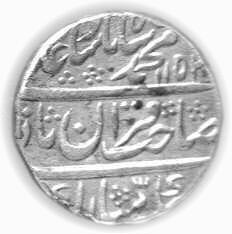
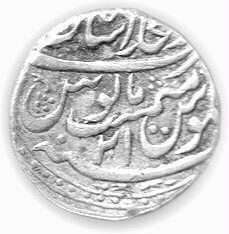
The suggestion, once made to me, that the coins of Muhammad Shah with regnal year 22 were the freshly minted rupees in the treasury when Nadir occupied Delhi and subsequently formed part of the immense booty taken by Nadir Shah from Delhi, cannot be correct. The story was that the Sikhs and Jats, who rose in his rear during his march back, plundered a portion of his baggage, including the rupees of year 22. The large number of these coins which must have appeared in trade all over Rajasthan may have been the reason that the princely state of Jaisalmer adopted this particular rupee as their own state issue., As shown by the dates above, however, this must be regarded as just another romantic myth. Coin inscriptions The following inscriptions and couplets appear on Nadir Shah’s coins struck in India.
PMC-10 and 50 (Lahore)
Obv.: nadir al-sultan
Nadir the Sultan
Rev.: zarb dar al-saltana lahor, khallad allah mulkahu (+date)
Struck at the seat of the Sultanate Lahore, May God perpetuate
his Kingdom
PMC-11 (Ahmadabad), 40 (Sarhind), 41 & 42 (Shahjahanabad), 49 (Lahore),
58 & 59 (Multan).
Obv.: sultan hast bar salatin jahan, shahanshah nadir sahib qiran
Sultan over the Sultans of the world, King of Kings Nadir, lord of
the fortunate conjunction of planets
Rev.: zarb (mint) khallad allah mulkahu (+ date)
Struck at (mint), May God perpetuate his Kingdom
PMC-43 (‘Azimabad)
Obv.: sikka mubarak bad shah ghazi nadir shah.(+date)
Auspicious coin of the victorious king Nadir Shah
Rev.: zarb ‘azimabad sana ahd julus maimanat manus
Struck at ‘Azimabad in the first year of his reign of tranquil
prosperity
PMC- 51-56 (Murshidabad)
Obv.: dadeh zib tazeh ru bar mihr wa mah, sikka nadir shah giií panah
(+date)
Given beauty fresh of face on the sun and moon (gold and silver)
by the stamp of Nadir Shah, Asylum of the Universe.
Rev.: zarb murshidabad sana ahd julus maimanat manus
Struck at Murshidabad in the first year of his reign of tranquil
prosperity
PMC-57 (Sarhind)
Obv.: sikka mubarak nadir shah bad shah sahib qiran (+date)
Auspicious coin of king Nadir Shah, lord of the fortunate
conjunction of planets.
Rev.: zarb dar al-aman sarhind sana ahd khallad allah mulkahu wa
saltanahu,
Struck at Dar al-Aman Sarhind in the first year of his reign, May
God perpetuate his Kingdom and his autocracy
The Num. Circ. LXXXVIII no.12 / ONS-NL 148 (Muhammadabad Banareas)
Obv.: sikka mubarak bad shah ghazi nadir shah (+ date)
Auspicious coin of the victorious king Nadir Shah
Rev.: zarb muhammadabad banaras sana ahd julus wala (maimanat manus)
Struck at Muhammadabad Banaras in the first year of his reign
(of tranquil prosperity)
1. H. Herrli, Zahlen, Ziffern, Zeitrechnungen; Ein Numismatisch Handbuch, Cologne 1989, pag. 92. 2. F.Pridmore, The Coins of the Commonwealth of Nations; part 4 India, volume I East India Company Presidency Series c1642-1835, London 1976, p. xxi-xxv. 3. S.H. Hodivala, Chronology of the reigns of the Mughal Emperors, Historical Studies in Mughal Numismatics, Bombay 1976, p.285. 4. M.B. Mitchiner and S.L. Goron, An Indian rupee struck at Banares in the name of the Persian ruler Nadir Shah, The Numismatic Circular, vol. LXXXVIII-12, December 1980 p.445-446. 5. Ken W. Wiggins, A rupee of Nadir Shah Afshari struck at Benares, ONS Newsletter 148, Spring 1996, p.23. 6. Willam Irvine, Later Mughals,(edited and augmented with the history of Nadir Shah’s Invasion by Jadunath Sarkar), reprint New Delhi 1971, p.307-379. 7. S. Bhattacharyya, The East India Company & the Economy of Bengal from 1704 to 1740, Calcutta 1969, p.118-120. 8. Bhattacharyya (1969), quoting from the Consultations, 23 April 1739. 9. R.B. Whitehead, Catalogue of Coins in the Panjab Museum, Lahore, Vol. III Coins of Nadir Shah and the Durrani Dynasty, Oxford 1934, no.43-pl.I.11. 10. Bhattacharyya (1969), quoting from the Consultations, 31 May 1739. 11. Irvine (1971), p.374. 12. Bhattacharyya (1969), quoting from the Consultations, 23 April 1739. 13. The double mohur is of poor style and abnormal weight (23,74 g.), its genuinity therefore may be doubted. The coin was acquired by the B.M. from Mr. C.J. Rogers, and was published in the Num. Chronicle 1882, Pl.XV. |
||||||||||||||
 | ||||||||||||||
| ons@onsnumis.org | © 1999-2024 ONS | |||||||||||||
